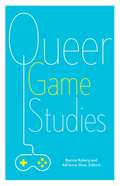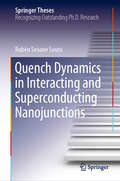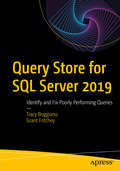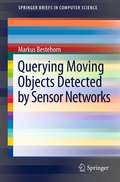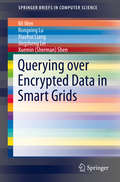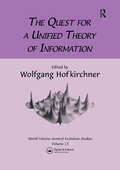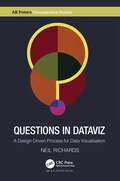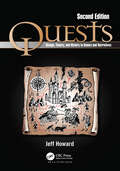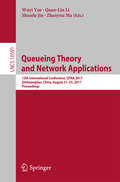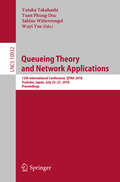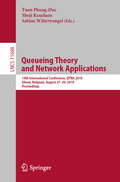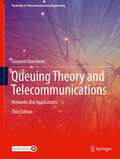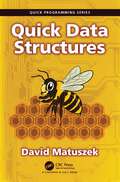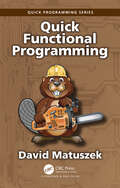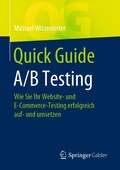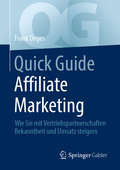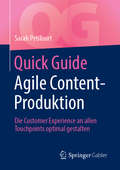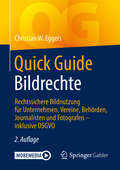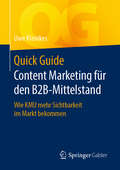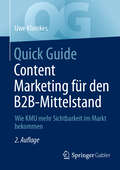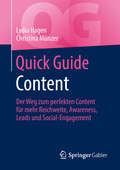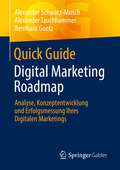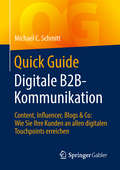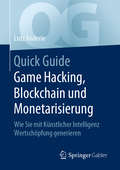- Table View
- List View
Queer Game Studies
by Adrienne Shaw Bonnie RubergVideo games have developed into a rich, growing field at many top universities, but they have rarely been considered from a queer perspective. Immersion in new worlds, video games seem to offer the perfect opportunity to explore the alterity that queer culture longs for, but often sexism and discrimination in gamer culture steal the spotlight. Queer Game Studies provides a welcome corrective, revealing the capacious albeit underappreciated communities that are making, playing, and studying queer games.These in-depth, diverse, and accessible essays use queerness to challenge the ideas that have dominated gaming discussions. Demonstrating the centrality of LGBTQ issues to the gamer world, they establish an alternative lens for examining this increasingly important culture. Queer Game Studies covers important subjects such as the representation of queer bodies, the casual misogyny prevalent in video games, the need for greater diversity in gamer culture, and reading popular games like Bayonetta, Mass Effect, and Metal Gear Solid from a queer perspective. Perfect for both everyday readers and instructors looking to add diversity to their courses, Queer Game Studies is the ideal introduction to the vast and vibrant realm of queer gaming. Contributors: Leigh Alexander; Gregory L. Bagnall, U of Rhode Island; Hanna Brady; Mattie Brice; Derek Burrill, U of California, Riverside; Edmond Y. Chang, U of Oregon; Naomi M. Clark; Katherine Cross, CUNY; Kim d&’Amazing, Royal Melbourne Institute of Technology; Aubrey Gabel, U of California, Berkeley; Christopher Goetz, U of Iowa; Jack Halberstam, U of Southern California; Todd Harper, U of Baltimore; Larissa Hjorth, Royal Melbourne Institute of Technology; Chelsea Howe; Jesper Juul, Royal Danish Academy of Fine Arts; merritt kopas; Colleen Macklin, Parsons School of Design; Amanda Phillips, Georgetown U; Gabriela T. Richard, Pennsylvania State U; Toni Rocca; Sarah Schoemann, Georgia Institute of Technology; Kathryn Bond Stockton, U of Utah; Zoya Street, U of Lancaster; Peter Wonica; Robert Yang, Parsons School of Design; Jordan Youngblood, Eastern Connecticut State U.
Quench Dynamics in Interacting and Superconducting Nanojunctions (Springer Theses)
by Rubén Seoane SoutoEffects of many-body interactions and superconducting correlations have become central questions in the quantum transport community. While most previous works investigating current fluctuations in nanodevices have been restricted to the stationary regime, Seoane's thesis extends these studies to the time domain. It provides relevant information about the time onset of electronic correlations mediated by interactions and superconductivity. This knowledge is essential for the development of fast electronic devices, as well as novel applications requiring fast manipulations, such as quantum information processing. In addition, the thesis establishes contact with issues of broad current interest such as non-equilibrium quantum phase transitions.
Query Store for SQL Server 2019: Identify and Fix Poorly Performing Queries
by Grant Fritchey Tracy BoggianoApply the new Query Store feature to identify and fix poorly performing queries in SQL Server.Query Store is an important and recent feature in SQL Server that provides insight into the details of query execution and how that execution has changed over time. Query Store helps to identify queries that aren’t performing well, or that have regressed in their performance. Query Store provides detailed information such as wait stats that you need to resolve root causes, and it allows you to force the use of a known good execution plan. With SQL Server 2017 and later you can automate the correction of regressions in performance. Query Store for SQL Server 2019 helps you protect your database’s performance during upgrades of applications or version of SQL Server. The book provides fundamental information on how Query Store works and best practices for implementation and use. You will learn to run and interpret built-in reports, configure automatic plan correction, and troubleshoot queries using Query Store when needed. Query Store for SQL Server 2019 helps you master Query Store and bring value to your organization through consistent query execution times and automate correction of regressions.What You'll LearnApply best practices in implementing Query Store on production serversDetect and correct regressions in query performanceLower the risk of performance degradation following an upgradeUse tools and techniques to get the most from Query StoreAutomate regression correction and other uses of Query StoreWho This Book Is ForSQL Server developers and administrators responsible for query performance on SQL Server. Anyone responsible for identifying poorly performing queries will be able to use Query Store to find these queries and resolve the underlying issues.
Querying Moving Objects Detected by Sensor Networks
by Markus BestehornDeclarative query interfaces to Sensor Networks (SN) have become a commodity. These interfaces allow access to SN deployed for collecting data using relational queries. However, SN are not confined to data collection, but may track object movement, e.g., wildlife observation or traffic monitoring. While rational approaches are well suited for data collection, research on Moving Object Databases (MOD) has shown that relational operators are unsuitable to express information needs on object movement, i.e., spatio-temporal queries. Querying Moving Objects Detected by Sensor Networks studies declarative access to SN that track moving objects. The properties of SN present a straightforward application of MOD, e.g., node failures, limited detection ranges and accuracy which vary over time etc. Furthermore, point sets used to model MOD-entities like regions assume the availability of very accurate knowledge regarding the spatial extend of these entities, assuming such knowledge is unrealistic for most SN. This book is the first that defines a complete set of spatio-temporal operators for SN while taking into account their properties. Based on these operators, we systematically investigate how to derive query results from object detections by SN. Finally, process spatio-temporal queries are shown in SN efficiently, i.e., reducing the communication between nodes. The evaluation shows that the measures reduce communication by 45%-89%.
Querying over Encrypted Data in Smart Grids
by Rongxing Lu Xuemin Sherman Shen Mi Wen Xiaohui Liang Jingsheng LeiThis SpringerBrief presents the concept of the smart grid architecture and investigates the security issues of the smart grid and the existing encrypted data query techniques. Unique characteristics of smart grid impose distinguished challenges on this investigation, such as multidimensional attributes in metering data and finer grained query on each dimension. Three kinds of queries are introduced, namely, equality query, conjunctive query and range query. For the equality query over encrypted metering data, an efficient searchable encryption scheme is introduced and can be applied for auction in emerging smart grid marketing. Later chapters examine the conjunctive query and range query over encrypted data. Different techniques are used, including the Public key Encryption with Keyword Search (PEKS) and Hidden Vector Encryption (HVE), to construct the comparison predicate and range query predicate. Their correctness is demonstrated in the book. Concise and practical, Encrypted Data Querying in Smart Grids is valuable for professionals and researchers involved in data privacy or encryption. It is also useful for graduate students interested in smart grid and related technologies.
Quest For A Unified Theory: Proceedings Of The Second International Conference On The Foundations Of Information Science
by Wolfgang HofkirchnerFirst published in 1999. Volume 13 in the 13-volume set titled World Futures General Evolution Studies with a common focus of the emerging field of general evolutionary theory. This volume will expand across disciplines where scholars from new fields will contribute books that propose general evolution theory in novel contexts. The essays are structured with five topics: Approaches to Unification; Concepts of Information; Self-Organizing Systems; Life and Consciousness; Society and Technology.
Questions in Dataviz: A Design-Driven Process for Data Visualisation (AK Peters Visualization Series)
by Neil RichardsThis book takes the reader through the process of learning and creating data visualisation, following a unique journey with questions every step of the way, ultimately discussing how and when to bend and break the "rules" to come up with creative, unique, and sometimes unconventional ideas. Each easy-to-follow chapter poses one key question and provides a selection of discussion points and relevant data visualisation examples throughout. Structured in three parts: Section I poses questions around some fundamental data visualisation principles, while Section II introduces more advanced questions, challenging perceived best practices and suggesting when rules are open to interpretation or there to be broken. The questions in Section III introduce further themes leading on to specific ideas and visualisation projects in more detail. Questions in Dataviz: A Design-Driven Process for Data Visualisation will appeal to any reader with an interest in creative or unconventional data visualisation and will be especially useful for those at a beginner or intermediate level looking for inspiration and alternative ways to deploy their data visualisation skills outside of conventional business charts.
Quests: Design, Theory, and History in Games and Narratives
by Jeff HowardCombining theory and practice, this updated new edition provides a complete overview of how to create deep and meaningful quests for games. It uses the Unity game engine in conjunction with Fungus and other free plugins to provide an accessible entry into quest design. The book begins with an introduction to the theory and history of quests in games, before covering four theoretical components of quests: their spaces, objects, actors, and challenges. Each chapter also includes a practical section, with accompanying exercises and suggestions for the use of specific technologies for four crucial aspects of quest design: • level design • quest item creation • NPC and dialogue construction • scripting This book will be of great interest to all game designers looking to create new, innovative quests in their games. It will also appeal to new media researchers, as well as humanities scholars in the fields of mythology and depth-psychology that want to bring computer-assisted instruction into their classroom in an innovative way. The companion website includes lecture and workshop slides, and can be accessed at: www.designingquests.com
Queueing Theory and Network Applications: 12th International Conference, QTNA 2017, Qinhuangdao, China, August 21-23, 2017, Proceedings (Lecture Notes in Computer Science #10591)
by Wuyi Yue, Quan-Lin Li, Shunfu Jin and Zhanyou MaThis book constitutes the proceedings of the 12th International Conference on Queueing Theory and Network Applications, QTNA 2017, held in Qinhuangdao, China, in August 2017. The 19 full papers included in this volume were carefully reviewed and selected from 65 initial submissions. They deal with queueing models; queueing applications; and network models.
Queueing Theory and Network Applications: 13th International Conference, QTNA 2018, Tsukuba, Japan, July 25-27, 2018, Proceedings (Lecture Notes in Computer Science #10932)
by Yutaka Takahashi Wuyi Yue Sabine Wittevrongel Tuan Phung-DucThis book constitutes the proceedings of the 13th International Conference on Queueing Theory and Network Applications, QTNA 2018, held in Tsukuba, Japan in July 2018.The 8 full papers together with 10 short papers included in this volume were carefully reviewed and selected from 57 initial submissions. All the papers to be presented disseminate the latest results covering up-to-date research fields such as performance modeling and analysis of telecommunication systems, retrial and vacation queueing models, optimization of queueing systems, modeling of social systems, application of machine learning in queueing models.
Queueing Theory and Network Applications: 14th International Conference, QTNA 2019, Ghent, Belgium, August 27–29, 2019, Proceedings (Lecture Notes in Computer Science #11688)
by Sabine Wittevrongel Tuan Phung-Duc Shoji KasaharaThis book constitutes the proceedings of the 14th International Conference on Queueing Theory and Network Applications, QTNA 2019, held in Ghent, Belgium, in August 2019.The 23 full papers included in this volume were carefully reviewed and selected from 49 initial submissions. The papers are organized in topical sections on Retrial Queues; Controllable Queues; Strategic Queues; Queueing Networks; Scheduling Policies; Multidimensional Systems; and Queueing Models in Applications.
Queuing Theory and Telecommunications: Networks and Applications (Textbooks in Telecommunication Engineering)
by Giovanni GiambeneThis thoroughly revised textbook provides a description of current networking technologies and protocols as well as important new tools for network performance analysis based on queuing theory. The third edition adds topics such as network virtualization and new related architectures, novel satellite systems (such as Space X, OneWeb), jitter and its impact on streaming services, packet level FEC techniques and network coding, new Markovian models, and advanced details on M/G/1 queuing models. The author also adds new selected exercises throughout the chapters and a new version of the slides and the solution manual. The book maintains its organization with networking technologies and protocols in Part I and then theory and exercises with applications to the different technologies and protocols in Part II. This book is intended as a textbook for master level courses in networking and telecommunications sectors.
Quick Data Structures (Quick Programming)
by David MatuszekIf you want to upgrade your programming skills, the most important thing you need is a solid understanding of fundamental data structures. The proper choice of data structures distinguishes excellent programmers from merely competent ones.As an experienced programmer, you use data structures—at least arrays—all the time. However, you may not be familiar with hash tables, trees and binary trees, priority queues, directed and undirected graphs, and other data structures at your disposal.A good choice of data structures will simplify your job, not complicate it. Your code will be not only faster but also easier to understand and debug. There is no downside to using the right data structures for the job.This book Provides an understanding of the fundamental building blocks of data structures Describes the construction and use of all common data structures Explains the simple math required for selecting efficient data structures Equips you with everything you need to choose data structures or devise appropriate new ones
Quick Functional Programming (Quick Programming)
by David MatuszekWhy learn functional programming? Isn’t that some complicated ivory-tower technique used only in obscure languages like Haskell? In fact, functional programming is actually very simple. It’s also very powerful, as Haskell demonstrates by throwing away all the conventional programming tools and using only functional programming features. But it doesn’t have to be done that way. Functional programming is a power tool that you can use in addition to all your usual tools, to whatever extent your current mainstream language supports it. Most languages have at least basic support. In this book we use Python and Java and, as a bonus, Scala. If you prefer another language, there will be minor differences in syntax, but the concepts are the same. Give functional programming a try. You may be surprised how much a single power tool can help you in your day-to-day programming.
Quick Guide A/B Testing: Wie Sie Ihr Website- und E-Commerce-Testing erfolgreich auf- und umsetzen (Quick Guide)
by Michael WitzenleiterDieses Buch zeigt Ihnen, wie Sie eine Testing-Strategie und Onsite-Optimierung in Ihrer Digital-Marketing-Praxis erfolgreich aufbauen und optimieren können. Michael Witzenleiter führt Sie Schritt für Schritt durch die entscheidenden Themen: von der Implementierung von A/B-Tests mit den richtigen Key-Performance-Indicators, der Ideen-Generierung für Ihre Tests über die Auswahl von Testing-Tools bis hin zu den zehn häufigsten Fehlern bei A/B-Tests, die Sie nach der Lektüre dieses Buches nicht mehr machen werden.Ein besonderer Vorzug dieses Buches: Sie erhalten Modelle, Vorgehensweisen und Praxistipps, die es Ihnen ermöglichen, das für Ihr Unternehmen bestmöglich individuelle Testing-Konzepte zu entwickeln. Dieser Quick Guide bietet Ihnen eine schnelle und zugleich umfassende Einführung in das Thema – leicht verständlich, anpassbar auf Ihre Situation und direkt umsetzbar in Ihrer Praxis.Aus dem InhaltStatistik-Basiswissen – kurz und verständlich, praxisnahWie Sie Ideen für Ihre A/B-Tests generierenImplementierung von A/B-TestsAufbau individueller Lösungen und Auswahl von A/B-TestingtoolsSo entwickeln Sie die notwendige Testing-KulturA/B-Testing in der Conversion-OptimierungZehn häufige Fehler bei A/B-TestsGlossar
Quick Guide Affiliate Marketing: Wie Sie mit Vertriebspartnerschaften Bekanntheit und Umsatz steigern (Quick Guide)
by Frank DegesDieser Quick Guide vermittelt in einer kompakten Übersicht die wesentlichen Schritte zum Aufbau und zur Steuerung von Vertriebspartnerschaften im Internet. An Beispielen wird aufgezeigt, wie Unternehmen das Affiliate Marketing optimal in ihre Vertriebsstrategie integrieren und dadurch Bekanntheit steigern und Umsatzpotenziale erschließen. Vertriebspartnerschaften mit Affiliates stehen für eine hohe Visibility und Bekanntmachung des Unternehmensangebotes, sie schaffen mit der Einblendung prägnanter Werbemittel Aufmerksamkeit in der Zielgruppe und stehen für eine effektive Form der Besucherfrequenzgenerierung und insbesondere Neukundengewinnung. Dieses Buch zeigt auf, wie Unternehmen eine Win Win Situation etablieren, indem über Affiliate Marketing der Unternehmensumsatz gesteigert wird und die Vertriebspartner attraktive Provisionen verdienen.
Quick Guide Agile Content-Produktion: Die Customer Experience An Allen Touchpoints Optimal Gestalten (Quick Guide)
by Sarah PetifourtDynamisch und nach personalisiertem Mehrwert suchend – so entwickelt sich unser derzeitiges Kommunikationsverhalten. Gleichzeitig werden Marken für Konsumenten immer wichtiger, obgleich deren Produkte nicht mehr einzigartig, sondern nahezu austauschbar sind. Neben neuen Ideen und nutzwertigen Inhalten sind mittlerweile auch strukturelle und technische Raffinessen notwendig, um Konsumenten zu erreichen. Zielführender Content – das heißt wirklich jede inhaltliche Botschaft, die ein Unternehmen kommuniziert – muss daher zu einem unverzichtbaren Tool in den Unternehmen werden. Aber wie produziert und steuert man diesen am besten? Die Antwort lautet: agil! Dieses Buch erklärt kompakt und fundiert, welche herausragende Bedeutung Content heute hat und wie agile Methoden für die Produktion von zielgruppenspezifischen Inhalten angewendet werden können, um potenzielle Kunden im entscheidenden Moment an allen Touchpoints digital abzuholen und langfristig zu binden. Ein nützliches Buch mit zahlreichen anschaulichen Beispielen, Transferaufgaben und Fragestellungen, die Ihnen die Anwendung in der Praxis erleichtern.
Quick Guide Bildrechte: Rechtssichere Bildnutzung für Unternehmen, Vereine, Behörden, Journalisten und Fotografen – inklusive DSGVO (Quick Guide)
by Christian W. EggersDieses Buch erläutert die rechtskonforme Verwertung von Bildrechten. Mit diesem bislang einmaligen Quick Guide erhalten Sie auf Basis der Datenschutzgrundverordnung (DSGVO) Antworten zu den häufigsten Fragen zur rechtskonformen Verwendung von Bildmaterial. Das Buch richtet sich insbesondere an Nicht-Juristen, die im Marketing, der Öffentlichkeitsarbeit oder im Bildrechtemanagement als Fotografen arbeiten. Erfahren Sie unter anderem:wie Sie Urheberrechtsfragen bei Bildern klärenwann und wie der Datenschutz bei Personenfotos von Events und Mitarbeiteraktivitäten greiftwelche Rechterklärungen Sie bei Fotos von geschützten Produkten, Logos, Markennamen und Designs einholen müssenwas Sie im Umgang mit Architektur- und Sachaufnahmen berücksichtigen müssenwas Sie bei der Nutzung von Bildern im Internet (beispielweise beim Datenschutz von Instagram) beachten müssenwie Sie mit gemeinfreien Bildern richtig umgehenDank des umfassenden Themenspektrums ist dieses Buch das ideale Nachschlagewerk, mit dem Sie Bildrechte garantiert konform zur DSGVO nutzen. Umfassende Darstellung aller wichtigen Themengebiete.Lesen Sie in den einführenden Kapiteln, wie Sie die Bildrechte zu Ihrem Motiv auf den ersten Blick erkennen und welche Nutzungs- und Motivrechte entsprechend Ihres Veröffentlichungskontextes gelten. In den weiteren Kapiteln bringt Ihnen der Autor folgende Rechtsaspekte näher:Menschen fotografieren: Recht am eigenen BildUmsetzung der Rechtsgrundlage „öffentliches Interesse“Anwendbarkeit des KUGCreativ Commons License BilderRechteklärung zur Veröffentlichung von PersonenfotosWie weit geht die Löschungspflicht von Fotodaten?Im Fokus stehen typische Anwendungsfälle der DSGVO bei der digitalen Publikation von Fotos, Videos, Logos und Designs. Zur Vertiefung der Inhalte finden Sie in diesem Buch viele Bildbespiele, Leitsätze und Checklisten. Ganz neu ist außerdem ein Frage-Antwort-Quiz mit SN Flashcards, mit dem Sie Ihr Wissen spielerisch vertiefen. Die vorliegende zweite Auflage wurde auf Basis der DSGVO vollständig aktualisiert (inkl. Online-Updates zur aktuellen Rechtsprechung) sowie um ein Kapitel zur Relevanz für die Öffentlichkeitsarbeit in Behörden und öffentlichen Stellen erweitert. Daher ist dieses Buch über die Verwendung von Bildrechten eine Empfehlung für:UnternehmenVereineBehördenJournalistenFotografen Inklusive digitalem Frage- und Antwort-Set (SN Flashcards) im gedruckten Buch.
Quick Guide Content Marketing für den B2B-Mittelstand: Wie KMU mehr Sichtbarkeit im Markt bekommen (Quick Guide)
by Uwe KleinkesContent Marketing ist in der heutigen digitalen Zeit ein wichtiges und erfolgsentscheidendes Werkzeug – und nicht nur großen Unternehmen vorbehalten. Auch kleinere Unternehmen mit B2B-Zielgruppen können Content Marketing gewinnbringend einsetzen.Dieser Quick Guide unterstützt mittelständische B2B-Unternehmen dabei, mittels Content-Marketing-Maßnahmen mehr Sichtbarkeit im Markt zu bekommen als ihre Wettbewerber. Das Buch erklärt alle grundlegenden Schritte, von Zielbestimmung über Analyse, Planung, Produktion und Management der Maßnahmen, und geht dabei auf die Besonderheiten im B2B-Markt ein.Marketing-Praktiker, die wenig Zeit und Vorkenntnisse haben, erhalten einen schnellen, grundlegenden Einblick sowie pragmatische Hilfestellungen für die Umsetzung. Ergänzend stellen Experten aus der Praxis ihre konkreten Projekte und Erfahrungen vor.Mit zahlreichen Checklisten zu einem organisierten, schrittweisen Vorgehen, umfangreichem weiterführendem Online-Arbeitsmaterial und Transferaufgaben für die individuelle Praxis.
Quick Guide Content Marketing für den B2B-Mittelstand: Wie KMU mehr Sichtbarkeit im Markt bekommen (Quick Guide)
by Uwe KleinkesDieser Quick Guide ist die ideale Unterstützung für mittelständische B2B-Unternehmen, die mit Content-Marketing-Maßnahmen ihre Sichtbarkeit im Markt erhöhen möchten. Das Buch bietet eine klare Struktur für Einsteiger und Marketing-Praktiker mit wenig Zeit oder Vorkenntnissen. Es deckt alle wesentlichen Schritte ab – von Zielbestimmung über Analyse, Planung, Produktion bis zum Management – und berücksichtigt die Besonderheiten des B2B-Marktes. Die 2. Auflage setzt ein starkes neues Highlight: Das Thema generative KI und ihr effektiver Einsatz im Content Marketing wird umfassend behandelt. Der Autor schildert effektive Toolnutzung, optimale Prompting-Strategien, Anwendungsbereiche und erklärt die Themen Ethik, Datenschutz und Urheberrecht. Mit zahlreichen Checklisten zu einem organisierten, schrittweisen Vorgehen, weiterführendem Online-Arbeitsmaterial für die individuelle Umsetzung sowie einem umfangreichen Praxisbeispiel.
Quick Guide Content: Der Weg zum perfekten Content für mehr Reichweite, Awareness, Leads und Social-Engagement (Quick Guide)
by Lydia Hagen Christina MünzerLernen Sie in diesem Content-Marketing-Buch, wie Sie überzeugende Inhalte für Ihre Webseite erstellenDieser „Quick Guide Content“ unterstützt Sie optimal dabei, überzeugende Inhalte im Content-Marketing zu erstellen. Content und SEO in Einklang zu bringen, ist heute eine zentrale und zugleich anspruchsvolle Aufgabe im Content-Marketing. Unternehmen, Online-Journalisten, Blogger und Redakteure müssen ihre Zielgruppe in nur wenigen Sekunden auf sich aufmerksam machen, um sich von ihren Wettbewerbern abzuheben. Hierfür stehen sie vor der Herausforderung, Inhalte zu schaffen, die einen tiefen Informationsgehalt garantieren und gleichzeitig schnell konsumierbar sind. Dieser praxiserprobte Leitfaden begleitet Sie dabei, gute Inhalte zu erstellen und sie erfolgreich zu verbreiten. Kompaktes und umsetzungsorientiertes WissenDamit Sie Ihre Inhalte zielgruppenspezifisch ausrichten und verbreiten können, müssen Sie zunächst die Notwendigkeit der Content-Erstellung und -Optimierung sowie die weiteren Schritte des Content-Managements verstehen. Hierfür liefert Ihnen der „Quick Guide Content“ schnell erschließbares, kompaktes und umsetzungsorientiertes Wissen. Sie erhalten verlässliche Fachinformationen, um mitreden, fundiert entscheiden und direkt handeln zu können. Mit Hilfe dieses praktischen Content-Marketing-Buchs gelingt Ihnen eine kontinuierliche Steigerung der Reichweite, Awareness und Conversion für Ihre beworbene Marke.Anschauliche Praxisbeispiele und nützliche Tool-TippsFundierte Zielgruppenanalysen und Themenrecherchen, die sich am Nutzerbedürfnis orientieren, sind relevant für die Erstellung von reichweitenstarkem Content. Sie müssen in jeder Stufe der Content-Erstellung und in den Phasen der Customer Journey die Suchmaschinenoptimierung (SEO) im Blick behalten. Nur so ist sichergestellt, dass Ihre Zielgruppe Ihre Inhalte auch finden kann. Anhand zahlreicher praxisnaher Beispiele (inkl. Tool-Tipps) erläutern die Autorinnen in ihrem Werk, wie Sie bei der Content-Implementierung in Ihrer Firma am besten vorgehen: Welchen Weg gibt es zum perfekten Content (Strategie, Audit, Recherchen etc.)?Wie stellen sich die Ressourcen für die zielgerichtete Umsetzung dar? Welche Themenpotenziale stehen Ihrem Unternehmen für die Umsetzung bereit? Wie und über welche Kanäle lassen sich die Inhalte verbreiten? Welche sind die richtigen KPIs im Content Marketing?Die Autorinnen begleiten Sie in diesem Content-Marketing-Buch Schritt für Schritt beim Content-Aufbau für Ihre Website.
Quick Guide Digital Marketing Roadmap: Analyse, Konzeptentwicklung und Erfolgsmessung Ihres Digitalen Marketings (Quick Guide)
by Alexander Schwarz-Musch Alexander Tauchhammer Bernhard GuetzIn diesem Buch wird mit der Digital Marketing Roadmap ein Konzept vorgestellt, mit dem Sie das Marketing Ihres Unternehmens im digitalen Umfeld planen, umsetzen und messen können. Die Digitalisierung bringt nahezu täglich neue Möglichkeiten und Tools, um mit Kunden in Kontakt zu treten und Kaufimpulse auszulösen. Gleichzeitig steigen die Anforderungen an das Marketing, den eigenen Beitrag zum Verkaufserfolg zu belegen. Hierzu braucht es einen strukturierten Fahrplan, um sicherzustellen, dass die einzelnen Maßnahmen auch messbar auf die Erreichung der Marketingziele einzahlen.Erfahren Sie in diesem Buch, wie Sie eine Digital Marketing Roadmap für Ihr Unternehmen entwickeln, dabei Customer Journey und Sales Funnel verbinden und Ihr Onlinemarketing durch Erfolgsmessung stetig verbessern.
Quick Guide Digitale B2B-Kommunikation: Content, Influencer, Blogs & Co: Wie Sie Ihre Kunden an allen digitalen Touchpoints erreichen (Quick Guide)
by Michael C. SchmittDieses Buch gibt einen kompakten Überblick über alle digitalen Kommunikationskanäle, die B2B-Unternehmen zielgerichtet für sich nutzen können, um Kunden auch in Zukunft auf sich aufmerksam zu machen, sie zu gewinnen und zu binden.Der Autor beschreibt, wie B2B-Unternehmen Content Marketing und Online-PR für sich nutzen, warum Videos hilfreiche Werkzeuge sind und welche Rolle Influencer bei der Ansprache von Business-Zielgruppen spielen. Er erklärt, wie Suchmaschinenoptimierung (SEO) funktioniert und welchen Regeln Social Media, Word of Mouth oder Unternehmensblogs unterliegen.Machen auch Sie einen Reality-Check Ihres Unternehmens und finden Sie heraus, mit welchen Kommunikationsmaßnahmen Ihr Unternehmen nachhaltig in Kontakt mit der Zielgruppe treten kann. Ein direkt anwendbares Buch, das Sie mit Transferübungen und Fragen für die Zukunft rüsten und inspirieren soll.
Quick Guide Domainmanagement: Wie Sie optimale Domainnamen finden und effektiv nutzen (Quick Guide)
by Frank DegesDieser Quick Guide vermittelt in kompakter Form die konzeptionellen, juristischen und technischen Grundlagen für ein effizientes Domainmanagement in Unternehmen. Eine Domain ist die Adresse, unter der eine Website oder ein Onlineshop im Internet aufzufinden sind. Der Domainname ist ein integraler Bestandteil der Markenpositionierung und Markenführung, er dient als Wegweiser im Internet und führt direkt zum Onlineangebot des Unternehmens.Die Kreation von Domainnamen ist eine langfristige Entscheidung, denn Fehler bei der Namensbildung sind nach dem erfolgreichen Aufbau und der nachhaltigen Etablierung eines Unternehmens oder einer Marke nur mit hohem Aufwand revidierbar. Deshalb ist bereits bei der Unternehmensgründung oder der Namensfindung für Marken und Produkte zu prüfen, ob der kreierte Domainname frei ist und registriert werden kann.Dieses Buch unterstützt Sie dabei, die perfekt auf Ihr Leistungsangebot und Ihre Zielgruppen ausgerichteten Domainnamen zu finden und Ihr wachsendes Domainportfolio effektiv zu managen. Mit zahlreichen Beispielen, Aufgaben und Inspirationen für Ihren Transfer in die Praxis.
Quick Guide Game Hacking, Blockchain und Monetarisierung: Wie Sie mit Künstlicher Intelligenz Wertschöpfung generieren (Quick Guide)
by Lutz AnderieKünstliche Intelligenz, Digitalisierung und Algorithmen Diese Themen verändern unsere Gesellschaft. Game Hacking, die Blockchain und Monetarisierung durch KI Systeme sind integraler Bestandteil der Computerspiele Branche, die mit ihrem Ökosystem seit Jahrzehnten Wachstum generiert und von hoher gesellschaftlicher und wirtschaftlicher Bedeutung ist.Dieser Quick Guide zeigt auf, wie Game Hacking und die damit einhergehende Entwicklung, Distribution und Vermarktung von Cheat Software funktioniert, einer Form der digitalen Produkt Piraterie und des Cybercrime. Auch die Blockchain, die nach dem Bitcoin-Hype ihr wahres Potenzial als Peer-to-Peer Distributed Ledger Technology entfaltet und mit welcher nicht nur Blockchain-Games entwickelt werden, ist verständlich erläutert und dokumentiert. Die Funktion und mögliche Bedeutung von In-Game Items als Crypto Currencies, Crypto Assets und Tokens wird hinterfragtKünstliche Intelligenz, Bestandteil einer jeden Game Engine, erfährt durch neue Monetarisierungsmodelle wie Cloud Gaming, Lootboxen und Steam Early Access neue Dimensionen, die in diesem Quick Guide verständlich erläutert sind. Finden Sie hier die wichtigsten inhaltlichen Punkte:Künstliche Intelligenz und Monetarisierung verstehenCloud Gaming, Lootboxen und Steam Early Access erfolgreich managenIn-Game Items, Crypto Assets und Tokenization wertsteigernd steuernBlockchain und Peer-to-Peer Distributed Ledger Technology anwendenGame Hacking, Cheat Software und Cybercrime abwehrenMachine Learning, neuronale Netze und Cyberconsciousness sowie deren Bedeutung für die Computerspiele Branche, werden aggregiert dargelegt, die jüngsten und zukünftigen Entwicklungen aufgezeigt. Alle Themengebiete werden konsequent aus der betriebswirtschaftlichen oder Managementperspektive dargelegt und bilden einen hohen Praxisbezug. Drei Experten- Interviews vertiefen die juristischen, technologischen und betriebswirtschaftlichen Dimensionen.
